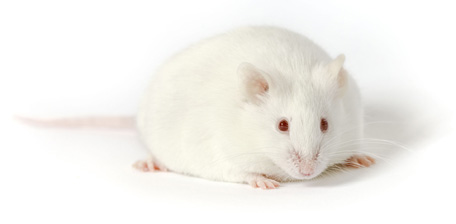 TALLYHO! Most people associate this word with the cry used in the British Isles to excite and prompt fox hunting hounds to chase after their quarry. At JAX, however, TALLYHO has an entirely different meaning. It’s the name of a relatively new polygenic model of moderate obesity and male-limited spontaneous type 2 diabetes (Kim et al. 2001). Unlike popular obesity/diabetes models, such as B6.V-Lepob/J ("ob/ob," 000632) and BKS.Cg-m +/+ Leprdb/J ("db/db," 000642) mice, which have defects in leptin or its receptor, the TALLYHO mice have normal leptin and leptin receptor genes, resulting in much less extreme metabolic syndrome and diabesity phenotypes.
TALLYHO! Most people associate this word with the cry used in the British Isles to excite and prompt fox hunting hounds to chase after their quarry. At JAX, however, TALLYHO has an entirely different meaning. It’s the name of a relatively new polygenic model of moderate obesity and male-limited spontaneous type 2 diabetes (Kim et al. 2001). Unlike popular obesity/diabetes models, such as B6.V-Lepob/J ("ob/ob," 000632) and BKS.Cg-m +/+ Leprdb/J ("db/db," 000642) mice, which have defects in leptin or its receptor, the TALLYHO mice have normal leptin and leptin receptor genes, resulting in much less extreme metabolic syndrome and diabesity phenotypes.
Several JAX scientists have recently added to our knowledge about the TALLYHO mouse: Dr. Adam Kennedy, study director, In Vivo Core Studies, California, recently compared the response to Rosiglitazone, a drug widely used to treat type 2 diabetes, between TALLYHO and db/db males. Dr. Yun Wang, D.V.M., Ph.D., and her colleagues have elucidated some of the molecular mechanisms responsible for the reduced glucose uptake in TALLYHO mice and have tested the involvement of a candidate gene for Tanidd1, a mouse chromosome 19 QTL associated with diabetes in TALLYHO mice. Their results will soon be published (Wang, pers. comm.) These and previous studies indicate that the TALLYHO strain is emerging as a potentially more appropriate model for identifying the molecular defects underlying type 2 diabetes. The most current information about the diabetes and obesity phenotypes of this important type 2 diabetes model is summarized below.
Origin
The TALLYHO/JngJ (TH) mouse strain (005314) was developed by Professor Jürgen Naggert’s research group at The Jackson Laboratory by using a backcross/intercross strategy and selecting for male hyperglycemia (Kim et al. 2001). Genome-wide SNP analyses indicate that TH is a Swiss-derived strain, related to ST/bJ (000688), SJL/J (000686), FVB/NJ (001800) and NON/ShiLtJ (002423). Most studies have compared the TH strain to the unrelated C57BL/6 (B6) strain.
Table 1. Comparison of selected diabetes and obesity phenotypes among humans and JAX® Mice strains NONcNZO10/LtJ (004456), an increasingly popular model of polygenic obesity-induced type 2 diabetes (Leiter and Reifsnyder 2004), the TH mouse, and the db/db mouse.
| Humans | NONcNZO10/LtJ (004456) |
TALLYHO/JngJ (005314) |
BKS.Cg- m +/+ Leprdb/J (000642) |
|
|---|---|---|---|---|
|
Induced or |
Spontaneous |
Spontaneous* |
Spontaneous |
Spontaneous |
|
Genetics |
Polygenic |
Polygenic |
Polygenic |
Polygenic |
|
Onset |
Mature |
Mature |
Mature |
Juvenile |
|
Sex |
M,F |
M,F |
M |
M,F |
|
Hyperinsulinemia |
Moderate |
Moderate |
Moderate |
Severe |
|
Glucose |
Yes |
Yes |
Yes |
Yes |
|
Hyperglycemia |
Yes |
Yes |
Yes |
Severe |
|
Islet atrophy |
Variable |
Yes |
Hypertrophy |
Yes |
| Obesity Phenotypes |
Humans | NONcNZO10/LtJ (004456) |
TALLYHO/JngJ (005314) |
BKS.Cg- m +/+ Leprdb/J (000642) |
|---|---|---|---|---|
|
Induced or |
Spontaneous |
Spontaneous* |
Spontaneous |
Spontaneous |
|
Genetics |
Polygenic |
Polygenic |
Polygenic |
Monogenic |
|
Onset |
Variable |
Mature |
Juvenile |
Juvenile |
|
Sex |
M,F |
M,F |
M,F |
M |
|
Degree |
Moderate |
Moderate |
Moderate |
Severe |
|
Hyper- |
Yes |
Yes |
Yes |
Yes |
|
Leptin/leptin |
Normal |
Normal |
Normal |
Disrupted |
|
Hyperphagia |
No |
No |
No |
Yes |
|
Hypercorticism |
No |
No |
ND |
Yes |
|
Thermoregulatory |
No |
No |
No |
Yes |
|
Liver steatosis |
Variable |
Moderate |
Moderate |
Severe |
*Severity of diabetes and obesity influenced by fat and carbohydrate content of the diet.
ND: not determined
Body weight
At four weeks, TALLYHO males are significantly heavier than C57BL/6J (000664) controls and become significantly heavier and more adipose with age (Kim et al. 2006). They gain significantly less weight, however, than do db/db mice (Kennedy 2008). Obesity in TALLYHO is associated with the TH-associated body weight 2 (Tabw2) QTL on mouse chromosome 6 (Kim et al. 2005).
Glucose levels
TALLYHO males are normoglycemic at weaning, but their plasma glucose levels rise with age. By eight weeks, TH males exhibit impaired glucose tolerance, accompanied by impaired 2-deoxyglucose uptake in muscle, and most post-pubertal males are chronically hyperglycemic (400-600 mg/dl). Females remain normoglycemic and may be used as controls (Kim et al. 2006). Hyperglycemia is associated with a recessive non-insulin-dependent diabetes mellitus 1 (Tanidd1) locus on mouse chromosome 19. Tanidd1 interacts with other loci, including Tanidd2 on chromosome 13, Tanidd3 on chromosome 15, TallyHo-associated body weight (Tabw1) on chromosome 7, and TallyHo-associated fat pad (Tafat) on chromosome 6 (Kim et al. 2001). Impaired glucose tolerance in young TH males may be due to leptin-mediated inhibition of insulin secretion (Sung et al. 2005).
Insulin levels
Male TALLYHO mice are moderately hyperleptinemic, and hyperinsulinemic, exhibiting plasma insulin levels between eight to 12 ng/ml after puberty (Kim et al. 2001, 2005, 2006).
Triglyceride levels
TALLYHO males exhibit a progressive, drastic and persistent rise in plasma triglyceride levels (300-600 mg/dl) (Kim et al. 2006).
Pancreatic islets
Both TALLYHO sexes develop early but moderate pancreatic islet hyperplasia/hypertrophy, but only males develop pathologic islet changes, including beta cell degranulation, some vacuolization and variable islet atrophy with scattered apoptotic cells and fibrotic changes (Kim et al. 2006).
Nephropathy
TALLYHO mice frequently develop bilateral hydronephrosis (Ed Leiter, Ph.D., and Yun Wang, D.V.M, Ph.D., The Jackson Laboratory, pers. comm.)
Vascular dysfunctions
Vascular dysfunctions in the aorta of TALLYHO mice are associated with enhanced contribution of prostaglandin H2/thromboxane A2 receptor and cytochrome p450, likely CYP2C6 and 2C9 (Cheng et al. 2007). Similar anomalies in cerebral arterioles and carotid arteries are possibly due to oxidative stress and enhanced activity of Rho kinase (Didion et al. 2007).
Response to Rosiglitazone
As mentioned earlier, JAX study director Adam Kennedy has compared the response to Rosiglitazone between TALLYHO and db/db males. TH males responded only to a high Rosiglitazone dose (30.0 mg/kg body weight vs. 0.3mg/kg body weight) (Kennedy 2008). The differential response may have been partly due to the db/db males weighing ~10 grams more than TH males. Similarly, only the highest dose of Rosiglitazone improved glucose tolerance in TH males.
We are very excited about the potential of the TALLYHO mouse in biomedical research. Both its unique diabetes and obesity phenotypes indicate that it will offer novel insights into the pathology and treatment of obesity and type 2 diabetes.
Figure 1. TH males responded only to high doses (30.0 mg/dl) of Rosiglitazone administered by gavage. Non-responsiveness to lower doses may be partly due to TH males weighing less and receiving less Rosiglitazone than db/db males.
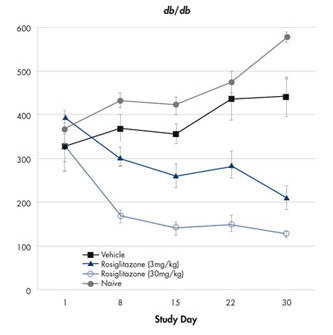
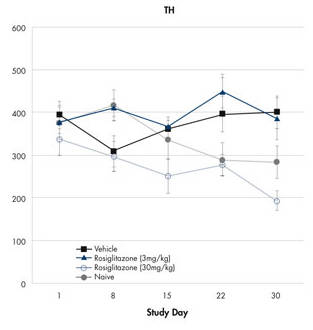
Figure 2. Glucose tolerance test (GTT) results in db/db and TH mice. Only the highest dose of Rosiglitazone improved glucose tolerance in TH males.
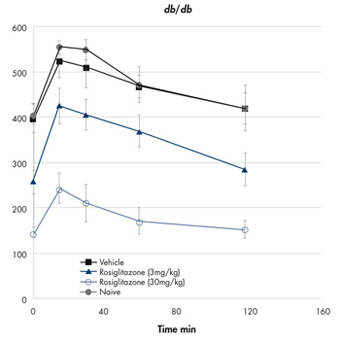
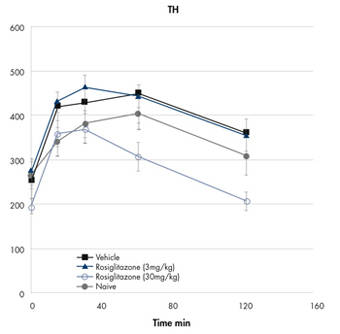
References
(Authors in bold are Jackson Laboratory scientists)
Cheng ZJ, Jiang YF, Ding H, Severson D, Triggle CR. 2007. Vascular dysfunction in type 2 diabetic TallyHo mice: role for an increase in the contribution of PGH2/TxA2 receptor activation and cytochrome p450 products. Can J Physiol Pharmacol 85:404-12.
Didion SP, Lynch CM, Faraci FM. 2007. Cerebral vascular dysfunction in TallyHo mice: a new model of type 2 diabetes. Am J Physiol Heart Circ Physiol 292:H1579-83.
Kennedy A. 2008. Unpublished research, The Jackson Laboratory.
Kim JH, Stewart TP, Soltani-Bejnood M, Wang L, Fortuna JM, Mostafa OA, Moustaid-Moussa N, Shoieb AM, McEntee MF, Wang Y, Bechtel L, Naggert JK. 2006. Phenotypic characterization of polygenic type 2 diabetes in TALLYHO/JngJ mice. J Endocrinol 191:437-46.
Kim JH, Stewart TP, Zhang W, Kim HY, Nishina PM, Naggert JK. 2005. Type 2 diabetes mouse model TallyHo carries an obesity gene on chromosome 6 that exaggerates dietary obesity. Physiol Genomics 22:171-81.
Kim JH, Sen S, Avery CS, Simpson E, Chandler P, Nishina PM, Churchill GA, Naggert JK. 2001. Genetic analysis of a new mouse model for non-insulin-dependent diabetes. Genomics 74:273-86.
Leiter EH, Reifsnyder PC. 2004. Differential levels of diabetogenic stress in two new mouse models of obesity and type 2 diabetes. Diabetes 53 Suppl 1:S4-11.
Sung YY, Lee YS, Jung WH, Kim HY, Cheon HG, Yang SD, Rhee SD. 2005. Glucose intolerance in young TallyHo mice is induced by leptin-mediated inhibition of insulin secretion. Biochem Biophys Res Commun 338:1779-87.